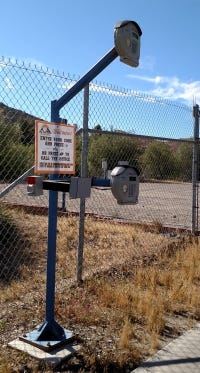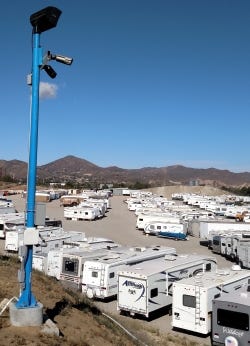Security Upgrades for Older Self-Storage Properties
A vendor turned self-storage facility manager shares how he upgraded the security system for a 27-acre property in Agua Dulce, Calif., and became an active part of the site’s overall security plan.
June 14, 2016
By Steve Weinstein
Making the leap from being a vendor to a self-storage facility manager was an eye-opening experience. I’ve worked as an industry security and software professional since 2004, but last year changed careers to become the manager of Agua Dulce Storage in Agua Dulce, Calif.
The 27-acre storage and parking facility offers 24-hour access and was little more than a glorified dirt lot when I signed on. Our vision was to turn it into a premiere storage facility with all the perks. I knew the software; I have good people skills; I can do installation and light maintenance on the various security systems, so it seemed like a natural fit. I didn’t realize how relevant my previous security experience would be.
Agua Dulce is in a fairly rural area, but not too far outside of Los Angeles proper. The surrounding region is all horse property and open mountains. There isn’t a lot of population density or the usual crime that tends to come with it.
For their security, the previous facility owners primarily relied on a couple of “yard-hand” employees who lived onsite. Now that there was no one living on the property, it needed more sophisticated measures to ensure the safety of tenants’ belongings. It had an automated gate and access-control system, an older analog video-surveillance system, and some lighting. It was time for upgrades.
Video Surveillance
The access-control system was solid and reliable; it did its job well. The video system was, unfortunately, not quite so robust.
 The cameras were an older analog type and simply not providing the clarity necessary for a property of this size. The night lighting consisted of energy-hungry, 400-watt, sodium-halide bulb fixtures sparsely sprinkled around the grounds, with a couple of 1,000-watt fixtures here and there. This created pools of light while the rest of the facility was in utter darkness, not to mention bright-star hot-spots if any camera was pointed toward a light.
The cameras were an older analog type and simply not providing the clarity necessary for a property of this size. The night lighting consisted of energy-hungry, 400-watt, sodium-halide bulb fixtures sparsely sprinkled around the grounds, with a couple of 1,000-watt fixtures here and there. This created pools of light while the rest of the facility was in utter darkness, not to mention bright-star hot-spots if any camera was pointed toward a light.
Our first step was to install a high-definition (HD) analog system. This is a great solution for operators of existing facilities with analog cameras. It enables them to upgrade to HD cameras and better-quality video without completely re-wiring the facility, which can be costly. HD analog uses standard coax cabling but provides mega-pixel-quality video.
Once installed, the cameras were great and provided a significant improvement. However, for a property this large, we simply needed more cameras and a more dynamic solution.
In a traditional analog surveillance system, each camera needs a dedicated wire from the camera to the digital video recorder. On a 27-acre property, this not only means a lot of wire, you quickly reach the effective distance limits of the system, which requires expensive “signal boosters” to go any further.
We decided to install an Internet-protocol (IP) camera system. With IP cameras, everything works on a Cat-5 Ethernet network, just like a computer network or the Internet. It greatly reduces wire and installation costs as well as “spaghetti syndrome” (jumbles of wiring) if done properly. Ethernet networks do still have an effective distance limit; however, this can be easily overcome with standard network hubs and switches to pass on the signal.
Lighting
With upgraded cameras, I now had a clear view of the property and could keep an eye on what was going on during the day. Unfortunately, the view at night, even though our cameras were infrared and equipped for night vision, was terrible. Did I mention we’re in a rural mountain area? It gets dark out here. A couple of our cameras were installed on light poles, but even with those, the effective viewing distance was severely limited. The others were worse.
Clearly, what we needed to do now was focus on lighting. The first thing to do was get rid of those huge, inefficient, sodium-halide lights. We replaced some of our fixtures with 150-watt LED lights and some with 300-watt. The 300-watt lights produce the equivalent of a 1,000-watt bulb, and the 150s the equivalent of a 400-watt bulb. They’re smaller, more efficient and brighter.
Right away we saw an incredible improvement. Something that I learned in this process: LED lighting seems to work especially well with today’s digital cameras! The picture quality in the areas with the new lighting was incredible. Since there weren’t enough existing light poles to completely eliminate all of the “dark zones” around the property, we’re adding new poles. This will also allow us to put a few cameras in key places to really round out our video-surveillance coverage.
Making It All Work
Now that all of this great new security is in place, what do I do with it? Monitoring the cameras while I’m onsite—and maybe even occasionally checking in remotely from home—is pretty much a no-brainer. I have large, flat-screen TVs in my office with the camera footage displayed prominently so I can view it from my desk and tenants can see it when they walk in. This allows me to monitor the facility and provides customers with a sense of security. We’re paying attention, our coverage is good, and the video quality is stunning. Yay for amenities and selling points!
 But what are these cameras doing for me after hours? I have a 27-acre facility with more than 700 spaces and 24-hour access. Certainly, I can look back at footage in the event that someone reports something, but that seems awfully passive. How can I be more proactive?
But what are these cameras doing for me after hours? I have a 27-acre facility with more than 700 spaces and 24-hour access. Certainly, I can look back at footage in the event that someone reports something, but that seems awfully passive. How can I be more proactive?
I realized there was a key part of my security system I wasn’t using to its full potential. My access-control system logs every keypad event, so I started reviewing gate-access logs every morning for suspicious or out-of-the ordinary activity. If I see anything, I look back at the footage and get an idea of what was going on.
A daily facility review (lock check and walk-through) keeps me in tune with the property on a personal level. I know who and what is where. If I see a tenant on camera in an area in which he has no business, I know to be on alert. It’s a sad truth, but with more than 700 spaces, it’s unreasonable to assume there won’t be at least one bad apple.
As a vendor, I knew what the various security tools were capable of individually and that they were all important to facility security. As a manager, I learned the most important part of site security is someone who uses these tools together to create a big picture. That’s how potential issues can be identified quickly and dealt with before they occur.
Steve Weinstein is the full-time property manager for Agua Dulce Storage, a 27-acre facility offering RV storage, container storage and parking in Agua Dulce, Calif. Steve worked for QuikStor Security & Software as a business-development consultant, service and installation technician, and support tech for 11 years. He still consults on software, security and access control but is really enjoying property management, working outdoors and building relationships with the tenants. For more information, e-mail [email protected]; visit www.aguadulcestorage.com.
You May Also Like





